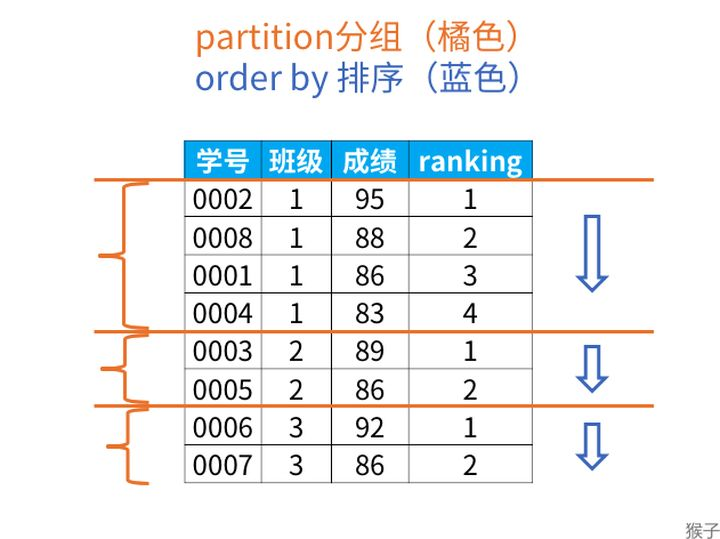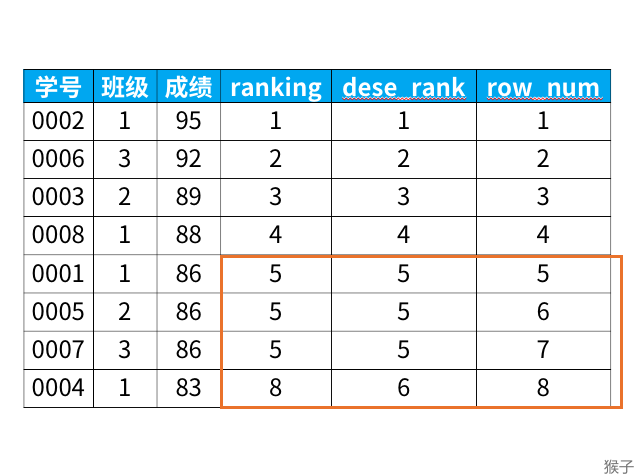字符串
(1)length(‘abcedfg’) 作用:返回字符串的长度
(2)reverse(‘abcedfg’) 作用:返回字符串的反转结果
(3)concat(‘abc’,'def’,'gh’) 作用:返回输入字符串连接后的结果,支持任意个输入字符串
concat_ws(‘,’,'abc’,'def’,‘gh’) 作用:返回输入字符串连接后的结果,’,'分隔符
(4)substr,substring(‘abcde’,3) 作用:返回字符串从3位置©到结尾的字符串
substr,substring(‘abcde’,3,2) 作用:返回字符串从3位置开始,长度为2的字符串
(5)upper,ucase(‘abSEd’) 作用:字符串转大写函数
lower,lcase(‘abSEd’) 作用:字符串转小写函数
(6)trim,ltrim,rtrim(‘ abc ‘) 作用:去除字符串两边的空格
(7)regexp_extract(‘foothebar’, ‘foo(.*?)(bar)’, 1) 作用:将字符串subject按照pattern正则表达式的规则拆分
(8)parse_url(‘http://facebook.com/path/p1.php?query=1’, ‘HOST’) 作用:解析URL字符串
(9)get_json_object(string json_string, string path) 作用:解析json函数
(10)space(int n) 作用:返回长度为n的字符串
(11)repeat(string str, int n) 作用:返回重复n次后的str字符串
(12)ascii(string str) 作用:返回字符串str第一个字符的ascii码
(13)lpad(string str, int len, string pad) 作用:将str进行用pad进行左补足到len位
rpad(string str, int len, string pad) 作用:将str进行用pad进行右补足到len位
(14)split(string str, string pat) 作用:按照pat字符串分割str,返回分割后的字符串数组
(15)find_in_set(string str, string strList) 作用:返回str在strlist第一次出现的位置
count
select
pt_day,
count(*),
count(uid),count(identifier),
count(distinct uid),count(distinct identifier),
count(case when appkey='CSIos' then identifier else null end),count(case when appkey='CSAndroid' then identifier else null end),
count(distinct case when appkey='CSIos' then identifier else null end),count(distinct case when appkey='CSAndroid' then identifier else null end),
count(case when appkey in ('CSIos','CSAndroid') then identifier else null end),
count(distinct case when appkey in ('CSIos','CSAndroid') then identifier else null end)
from bi_all_access_log
where pt_day between '2017-11-01' and '2017-11-14'
group by pt_day
order by pt_day
1.count(*)、count(1):
count(*)对行的数目进行计算,包含NULL,count(1)这个用法和count(*)的结
果是一样的。
如果表没有主键,那么count(1)比count(*)快。表有主键,count(*)会自动优化
到主键列上。
如果表只有一个字段,count(*)最快。
count(1)跟count(主键)一样,只扫描主键。count(*)跟count(非主键)一样,
扫描整个表。明显前者更快一些。
count(1)和count(*)基本没有差别,但在优化的时候尽量使用count(1)
2.count(1)、count(列名):
(1) count(1) 会统计表中的所有的记录数,包含字段为null 的记录。
(2) count(字段) 会统计该字段在表中出现的次数,忽略字段为null 的情况。
即不统计字段为null 的记录。
日期格式设置
系统时间:from_unixtime(unix_timestamp() ,'yyyy-MM-dd HH:mm:ss') as ins_date
固定日期转换成时间戳
select unix_timestamp('2016-08-16','yyyy-MM-dd') --1471276800
select unix_timestamp('20160816','yyyyMMdd') --1471276800
select unix_timestamp('2016-08-16T10:02:41Z', "yyyy-MM-dd'T'HH:mm:ss'Z'") --1471312961
时间戳转换程固定日期
select from_unixtime(1471276800,'yyyy-MM-dd') --2016-08-16
select from_unixtime(1471276800,'yyyyMMdd') --20160816
select from_unixtime(1471312961) -- 2016-08-16 10:02:41
select from_unixtime( unix_timestamp('20160816','yyyyMMdd'),'yyyy-MM-dd') --2016-08-16
select date_format('2016-08-16','yyyyMMdd') --20160816
返回日期时间字段中的日期部分
select to_date('2016-08-16 10:03:01') --2016-08-16
返回日期中的年
select year('2016-08-16 10:03:01') --2016
返回日期中的月
select month('2016-08-16 10:03:01') --8
返回日期中的日
select day('2016-08-16 10:03:01') --16
返回日期中的时
select hour('2016-08-16 10:03:01') --10
返回日期中的分
select minute('2016-08-16 10:03:01') --3
返回日期中的秒
select second('2016-08-16 10:03:01') --1
返回日期在当前的周数
select weekofyear('2016-08-16 10:03:01') --33
返回结束日期减去开始日期的天数
select datediff('2016-08-16','2016-08-11')
返回开始日期startdate增加days天后的日期
select date_add('2016-08-16',10)
返回开始日期startdate减少days天后的日期
select date_sub('2016-08-16',10)
返回当月的第一天
select trunc('2016-08-16','MM') --2016-08-01
select trunc('2016-08-16','YEAR') --2016-01-01
返回当天记录
select * from table_1 where date_col>=date(now()) and date_col<DATE_ADD(date(now()),INTERVAL 1 DAY)
计算累加和
每天的累加和、以及累积和-50、累加和-100 (设此临时表为qq)
select
name,
costdate,
--每天消费金额
num,
--累加和
sumnum,
sumnum-50 as num_50,
sumnum-100 as num_100
from
(
select name,costdate,num,sum(num) over(partition by name order by costdate) as sumnum
from aa
)aaa
NVL函数
-
NVL(E1, E2)的功能为: - 如果E1为NULL,则函数返回E2,否则返回E1本身。但此函数有一定局限,所以就有了NVL2函数
-
NVL2(E1, E2, E3)的功能为:如果E1为NULL,则函数返回E3,若E1不为null,则返回E2
(NVL2函数:Oracle/PLSQL中的一个函数,Oracle在NVL函数的功能上扩展,提供了NVL2函数)
时间戳函数
1.unix_timestamp
1)返回当前时间的时间戳
select unix_timestamp();
2)如果参数date满足yyyy-MM-dd HH:mm:ss形式,则可以直接unix_timestamp(string date) 得到参数对应的时间戳
或者满足yyyy-MM-dd形式
select unix_timestamp('2018-12-05 01:10:00','yyyy-MM-dd HH:mm:ss');
select unix_timestamp('2018-12-05','yyyy-MM-dd');
2.from_timestamp
-
把时间戳转换成时间格式
from_unixtime(tt) -
tt为10位数的时间戳
select from_unixtime(1543943400); -
from_unixtime(tt,‘yyyy-MM-dd’) 可以加上时间格式
select from_unixtime(1543943400,'yyyy-MM-dd');
窗口函数
1.窗口函数有以下功能:
1)同时具有分组和排序的功能
2)不减少原表的行数
3)语法如下:
<窗口函数> over (partition by <用于分组的列名>
order by <用于排序的列名>)
2.举例
-
假设现在要对成绩排序,每个班级分别降序:
select *, rank() over (partition by 班级 order by 成绩 desc) as ranking from 班级表

3.其他专业窗口函数
-
专用窗口函数:rank, dense_rank, row_number的区别
select *, rank() over (order by 成绩 desc) as ranking, dense_rank() over (order by 成绩 desc) as dese_rank, row_number() over (order by 成绩 desc) as row_num from 班级表

- 如上图:对同分项处理方式不同;排名/不排名,占位/不占位
hive数据去重,并根据需求取其中一条
-
数据案例:
name adx tran_id cost ts ck 5 125.168.10.0 33.00 1407234660 ck 5 187.18.99.00 33.32 1407234661 ck 5 125.168.10.0 33.24 1407234661 -
只需要前两行的记录,因为第三行的tran_id和第一行的重复了,所以需要将最后面一行重复的去掉。
-
方案一:
select t1.tran_id,t2.name,t2.cost from (selectdistinct tran_id from table) t1 join table t2 on t1.tran_id=t2.tran_id -
分析:
如果使用distinct的话,需要把tran_id放在第一列,查出来的数据很不友好。 -
方案二:
select* from( select *, row_number() over (partition by tran_id order by timestamp desc) num from table ) t where t.num=1; -
分析:
row_number() over (partition by tran_id order by timestamp desc) num 取num=1的意思是先根据tran_id进行分组,并在分组内部按timestamp降序排序,row_number()函数计算的值就表示某个tran_id组内部排序后的顺序编号(该编号在一个组内是连续并且唯一的)
所以最后直接去每个分组内的第一个(num=1)即可
笛卡尔积关联(cross join):
-
返回两个表的笛卡尔积结果,不需要指定关联键
select a.id,a.name,b.age from rdb_a a cross join rdb_b b; Total MapReduce CPU Time Spent: 1 seconds 260 msec OK 1 lucy 12 1 lucy 22 1 lucy 32 2 jack 12 2 jack 22 2 jack 32 3 tony 12 3 tony 22 3 tony 32 Time taken: 24.727 seconds, Fetched: 9 row(s)
最后
以上就是活泼白云最近收集整理的关于常用数据库查询语句hivesql的全部内容,更多相关常用数据库查询语句hivesql内容请搜索靠谱客的其他文章。








发表评论 取消回复